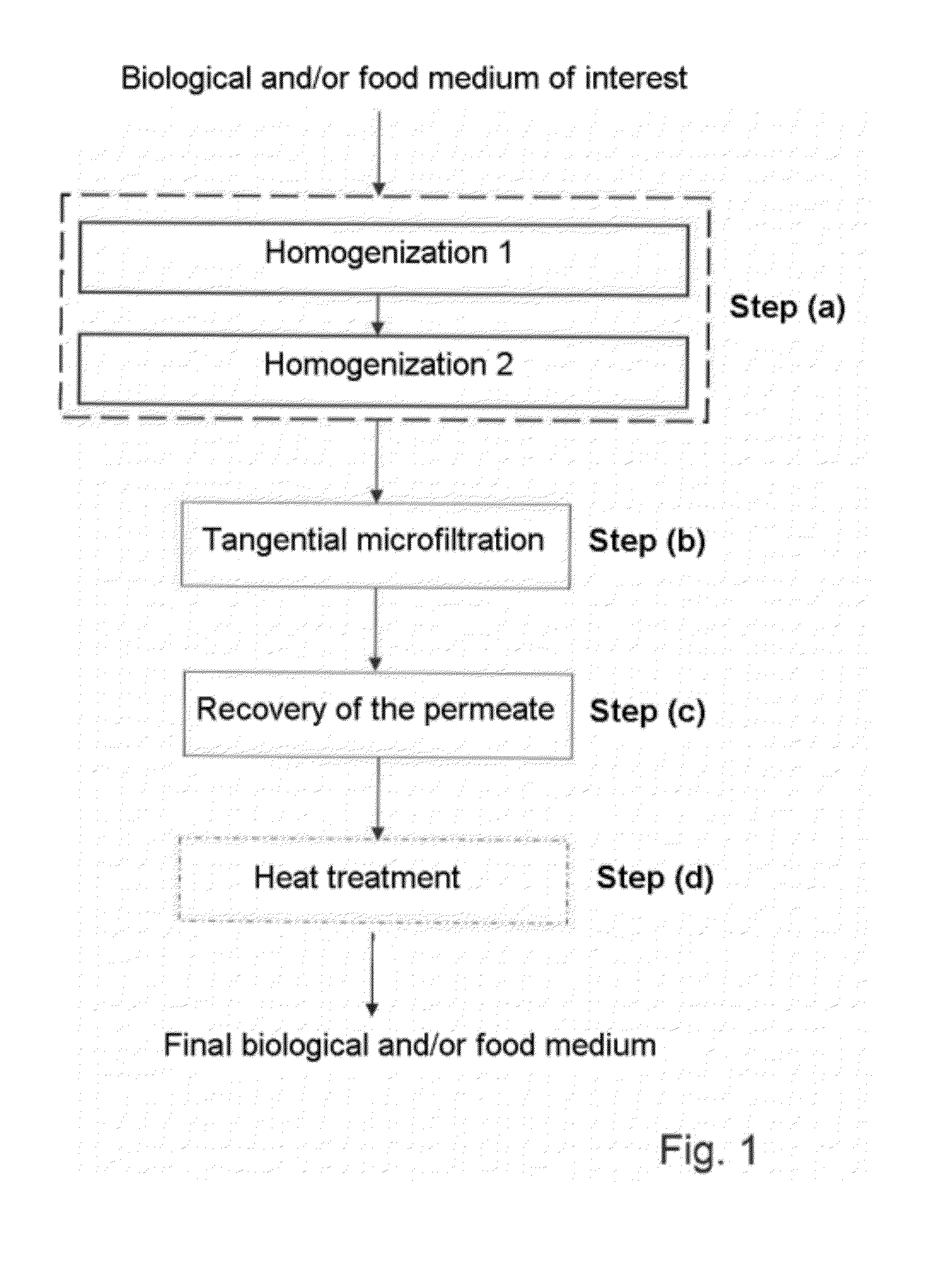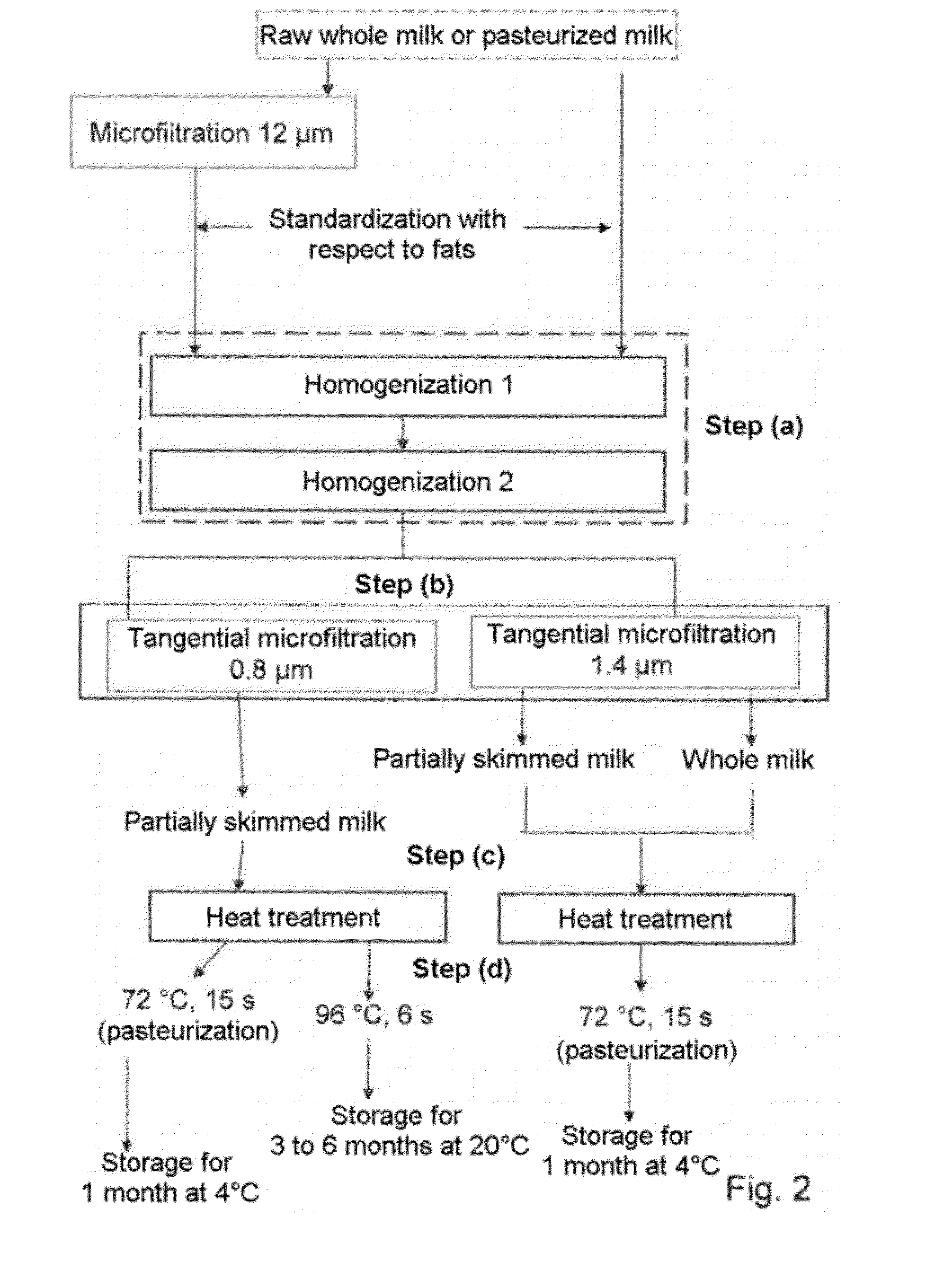Method for Reducing the Bacterial Content of a Food and/or Biological Medium of Interest Containing Lipid Droplets
a technology of biological media and lipid droplets, which is applied in the field of microbial decontamination of food and/or biological media containing lipids, can solve the problems of irreversible alteration of certain components of milk, adverse effects on the organoleptic and nutritional qualities of certain media, and inability to meet the requirements of storage,
- Summary
- Abstract
- Description
- Claims
- Application Information
AI Technical Summary
Benefits of technology
Problems solved by technology
Method used
Image
Examples
embodiments
[0348]The invention is further illustrated, without being limited in any way, by the description of various embodiments of the method for treating mammalian milk, referring to FIGS. 3 to 10. The conditions applied at each step, notably of homogenization and of microfiltration, are advantageously as detailed above.
[0349]FIG. 3 is a scheme of a process for obtaining a partially skimmed milk, preferably semi-skimmed with 15 g / kg of fats, which is sterile, and has high organoleptic and nutritional values.
[0350]This method consists of obtaining a supply of whole milk, raw or pasteurized, constituting the medium of interest.
[0351]A separating step is applied to this medium of interest, so as to separate the skimmed milk (raw or pasteurized) and the cream.
[0352]A proportion of the cream thus obtained is added back in the skimmed milk so as to standardize the latter with respect to fats (for example 18 g / kg, to compensate the losses and the yield of the subsequent steps). The unused portion...
example 1
Effect of the Pressure During Application of Two Successive Homogenization Operations, on the Diameter of the Lipid Droplets of Whole Milk and of Semi-Skimmed Milk
[0404]Starting Material
[0405]Mixed cow's milks, which were standardized to produce a whole milk (36 to 40 g / kg) and a semi-skimmed milk (18 to 20 g / kg).
Experimental Conditions:
[0406]Homogenizer used: Rannie Lab 12 / 51H (APV, Evreux, France)
[0407]Parameterization: Pressures between 200 and 1000 bar; Inlet temperature=45 ±1° C.; Flow rate=100 to 120 L / h
[0408]Determination of the granulometric parameters of the lipid droplets: Mastersizer 2000 (Malvern, UK)
Results:
[0409]The results are shown in FIGS. 11 to 13, with the percentage of particles larger than 0.3 μm, 0.5 μm and 0.8 μm respectively, as a function of the pressure and of the homogenization number.
[0410]In the case of two successive homogenizations at a pressure of 800 bar, in particular the following granulometric parameters of the lipid droplets are obtained: mode=0....
example 2
Tangential Microfiltration on a 0.8-μm Membrane
Starting Material:
[0415]Mixed cow's milk standardized with respect to fats and homogenized twice.
Microfiltration Membranes:
[0416]Mineral membranes (PALL EXEKIA, Tarbes, France; 19 channels with 4 mm diameter; 1P19-40) with a cutoff of 0.8 μm and a double layer of alumina (Sterilox), were used.
[0417]Tangential microfiltration was carried out with a uniform transmembrane pressure (UTP), on membranes of different lengths: 0.85 m and 1.02 m, corresponding to an area of 0.2 m2 and 0.24 m2 respectively.
[0418]The results presented below were obtained with a membrane with a length of 1.02 m (area 0.24 m2).
Microfiltration Parameters:
[0419]The sweep rate selected is 7 m / s.
[0420]The feed pressure used varied from 1.7 to 2 bar.
[0421]The temperature at which microfiltration is carried out is 56±1° C.
[0422]The volume concentration factor (VCF) is fixed at 10.
[0423]The permeation flow rate is fixed at 200 L / h / m2.
[0424]Microfiltration was carried out f...
PUM
 Login to View More
Login to View More Abstract
Description
Claims
Application Information
 Login to View More
Login to View More - R&D
- Intellectual Property
- Life Sciences
- Materials
- Tech Scout
- Unparalleled Data Quality
- Higher Quality Content
- 60% Fewer Hallucinations
Browse by: Latest US Patents, China's latest patents, Technical Efficacy Thesaurus, Application Domain, Technology Topic, Popular Technical Reports.
© 2025 PatSnap. All rights reserved.Legal|Privacy policy|Modern Slavery Act Transparency Statement|Sitemap|About US| Contact US: help@patsnap.com



